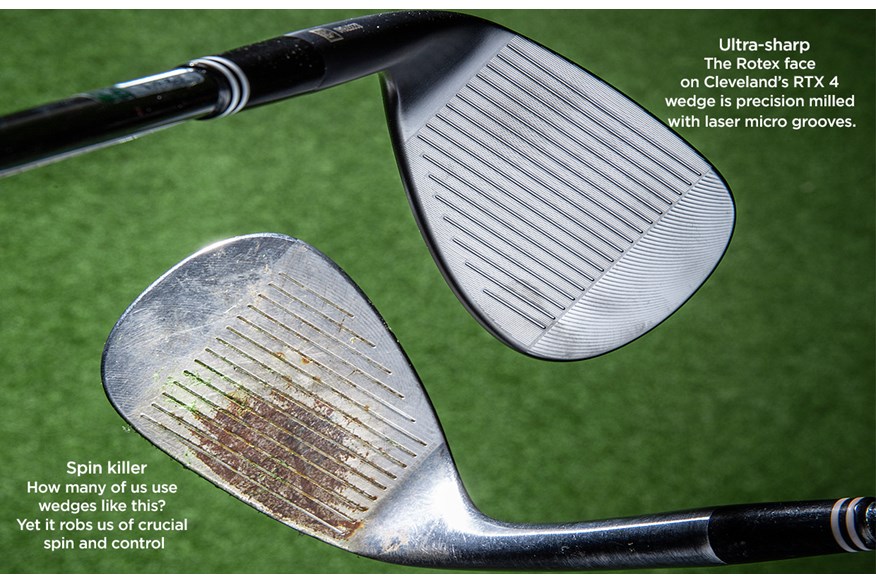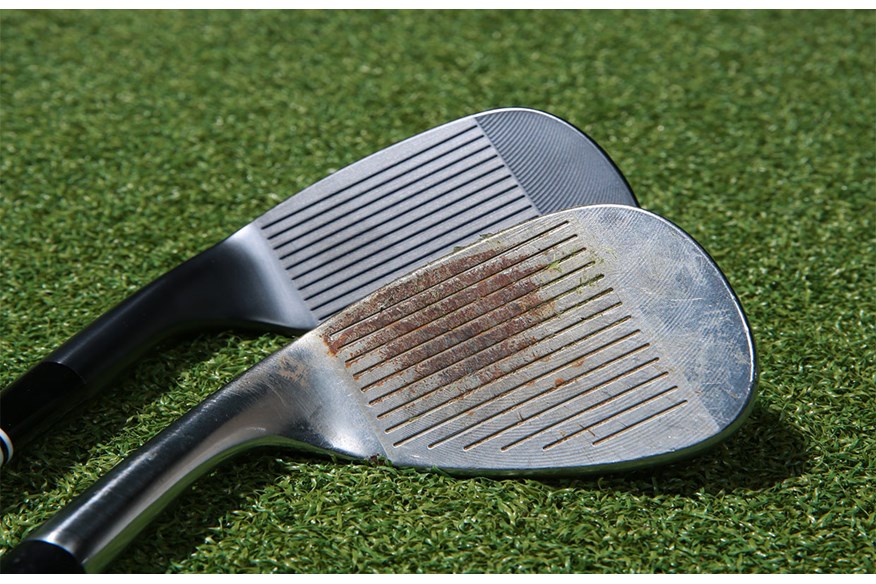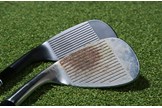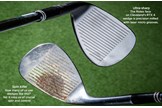How much spin are you sacrificing with an old wedge?
Last updated:
How much spin does using an old golf wedge cost you? We pitted a fresh Cleveland model against a well-used older club to find out.
We tested a fresh Cleveland RTX 4 wedge against a used five-year-old Cleveland 588 RTX 2.0.
Tour players can be really picky when it comes to wedges. Each player wants his own perfect loft, sole grind, head shape and finish, which sounds like a lot of personalisation work for manufacturers when a 150 players turn up each week on Tour.
But it’s how the world’s best players insist on the sharpest, freshest grooves – to generate maximum spin on approach shots – that makes keeping Tour players supplied with wedges a full-time job for brands like Cleveland. Tour pros practice their short game a lot. So much so in fact, that some players insist six weeks is the maximum they can use a wedge before the grooves dull and they need a replacement.
RELATED: Robot Tested: Which golf ball suits my game?
And that stat got us thinking… If Tour pros are changing wedges every six weeks, how much do club golfers sacrifice by keeping old favourite wedges in the bag for longer than the natural life expectancy? We’ve seen three, four even five-year-old wedges in the bags of club golfers… some with more grass and soil in their grooves than there is on a golf hole!
We know that grooves lose their sharpness over time, so they’ll impart less spin and control, but how much are we talking? We wanted to find out…
Old vs new golf wedge test: How we did it
We asked wedge maestros Cleveland to send us not only a brand spanking new RTX 4 – complete with razor-sharp Rotex grooves – but also wedge that was a few years old and well used.
They sent a 588 RTX 2.0 (and an equivalent lofted RTX 4) which was introduced in 2014 – five years old is considered a normal life expectancy for a club golfer’s wedge. Its grooves were in a similar condition to many we’ve seen in golfers’ bags over the years – worn, rusty and full of muck.

We then asked our regular test pro Neil Wain to hit a series of 60-yard shots (as it’s the shortest distance golfers hit that demands maximum spin and control).
We used premium Tour level balls and a Foresight GC Quad launch monitor to record data for each shot hit. After analysing the data we could see for certain how much worn out grooves really affect spin and control.
RELATED: Tested: Best Wedges 2020
Old vs new golf wedge test: What happened
It’s important to point out even though both wedges were Cleveland models, a five-year difference in age means face and groove tech has moved on significantly since the 588 RTX hit the market.
The RTX 4 features sharper groove edges, thanks to better micro and laser milling for increased surface friction along with improved milling techniques. And because the 588 RTX doesn’t have Feel Balancing tech like the RTX 4, the centre of gravity is closer to the hosel, too.
We’ve seen with tests like this before that it’s possible to see 1000rpm or more spin difference on full shots, but we were still surprised to see a very similar difference for 60-yard shots where the clubhead is travelling much slower. Our pro saw a massive backspin drop-o of 1135rpm from the new grooves to the old, worn ones.
| Club | Backspin (60 yard pitch shot) |
| 588 RTX 2.0 | 7,959rpm |
| RTX 4 | 9,094rpm |
So if we can prove worn wedge grooves mean less spin, how do you know if your wedges are due for an upgrade? It’s not an easy question to answer as golfers all play and practice different amounts. But if your wedge face looks anything like our 588 RTX here, you really should be considering an upgrade some time soon.
Remember different turf types make a difference to groove wear, too – the more sandy the soil the faster the wear, and if you practice from bunkers they’ll dull even quicker. We wouldn’t go as far as saying you need a new wedge every six weeks like a Tour player, but replacing your wedges every 12 or 18 months really makes sense.
RELATED: Tested: Cleveland RTX Zipcore vs Titleist Vokey SM8 wedge
Old vs new golf wedge test: The Verdict
Over 1,100rpm of spin is an awful lot to be sacrificing by using an old, worn wedge. That’s more than enough to make a significant difference in getting an approach to stop, whether you’re 60 yards from the flag, 100 yards out, in a greenside bunker or looking for control out of the rough.
READ NEXT: Best Wedges 2020 – Ranked by Spin Rate


